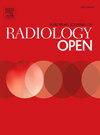The role of resting-state perfusion CMR in the evaluation of microvascular obstruction in patients with acute myocardial infarction: A clinical perspective
IF 2.9
Q3 RADIOLOGY, NUCLEAR MEDICINE & MEDICAL IMAGING
引用次数: 0
Abstract
Objectives
To investigate the clinical application value of cardiac resting-state perfusion weight imaging (rs-PWI)-derived parameters in patients with acute myocardial infarction (AMI) complicated by microvascular obstruction (MVO).
Methods
Overall, 300 patients with AMI were prospectively enrolled, and divided into the MVO and non-MVO groups, based on the presence of MVO in the infarcted myocardium. Differences in rs-PWI imaging parameters, and the diagnostic value of rs-PWI in reperfusion myocardial ischemia at segment level and MVO were quantitatively evaluated.
Results
The average age was 58.60 ± 13.03 years, and 246/300 (82 %) were males. The MVO group had 176 patients (mean age: 57.90 ± 12.47), including 140 (80 %) males. The left ventricular (LV) volumes occupied by the infarcted myocardium were 19.60 ± 2.70 %LV and 15.20 ± 3.40 %LV in the MVO and non-MVO groups, respectively (P < 0.05). There were 679 LGE positive segments in the MVO group (679/2816, 24.1 %). The area under curve (AUC), sensitivity, specificity, and Jordan index of rs-PWI for MVO diagnosis were 0.95(0.89–0.99), 94.3 %, 93.4 %, and 0.88, respectively. At the segmental level, the maximum rising slope was higher in the MVO than non-MVO group (15.09 ± 2.64 vs. 6.21 ± 1.25, P < 0.05). The time to peak 20 %-80 % was shorter in the MVO group (4.07 ± 0.79 vs. 7.75 ± 1.03, P < 0.05). Comparison revealed differences in perfusion indices (MVO: 0.32 ± 0.09 vs. non-MVO: 0.42 ± 0.04, P < 0.05). The highest diagnostic value for MVO among rs-PWI parameters was AUC 0.90(0.84–0.97), sensitivity 94.1 %, specificity 88.7 %, and accuracy 91.1 %.
Conclusion
CMR rs-PWI sequence effectively evaluates reperfusion myocardial ischemia complicated with MVO, while the perfusion index has high diagnostic value in quantifying myocardial blood flow potential.
静息状态灌注CMR在评估急性心肌梗死患者微血管阻塞中的作用:临床视角
目的探讨心脏静息状态灌注权重成像(rs-PWI)衍生参数在急性心肌梗死(AMI)合并微血管阻塞(MVO)患者中的临床应用价值。方法前瞻性纳入300例AMI患者,根据梗死心肌是否存在MVO分为MVO组和非MVO组。定量评价rs-PWI成像参数的差异,以及rs-PWI在节段水平和MVO再灌注心肌缺血中的诊断价值。结果平均年龄58.60 ± 13.03岁,男性占246/300,占82 %。MVO组176例患者(平均年龄:57.90 ± 12.47),其中男性140例(80% %)。MVO组和非MVO组梗死心肌占左室容积分别为19.60 ± 2.70 %LV和15.20 ± 3.40 %LV (P <; 0.05)。MVO组LGE阳性节段679个(679/2816,24.1% %)。rs-PWI诊断MVO的曲线下面积(AUC)、敏感性、特异性和Jordan指数分别为0.95(0.89 ~ 0.99)、94.3 %、93.4 %和0.88。在节段水平上,MVO组的最大上升斜率高于非MVO组(15.09 ± 2.64 vs. 6.21 ± 1.25,P <; 0.05)。MVO组达到峰值20 %-80 %的时间较短(4.07 ± 0.79 vs. 7.75 ± 1.03,P <; 0.05)。比较各组灌注指标差异(MVO组:0.32 ± 0.09 vs.非MVO组:0.42 ± 0.04,P <; 0.05)。rs-PWI参数对MVO的最高诊断价值为AUC 0.90(0.84-0.97),敏感性94.1 %,特异性88.7 %,准确性91.1 %。结论cmr rs-PWI序列可有效评价心肌再灌注缺血合并MVO,灌注指数在定量心肌血流电位方面具有较高的诊断价值。
本文章由计算机程序翻译,如有差异,请以英文原文为准。
求助全文
约1分钟内获得全文
求助全文
来源期刊

European Journal of Radiology Open
Medicine-Radiology, Nuclear Medicine and Imaging
CiteScore
4.10
自引率
5.00%
发文量
55
审稿时长
51 days
 求助内容:
求助内容: 应助结果提醒方式:
应助结果提醒方式:


